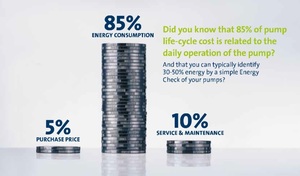

|
Edward Lowton
Editor |


|
| Home> | Plant, Process & Control | >Pumps | >Optimising pump systems for improved performance |
Optimising pump systems for improved performance
10 February 2023
Given the global rise in energy costs, there has never been a better time to review and assess the efficiency of your pumping systems - whatever their size, complexity or indeed area of operation, says Gary Wilde

PUMP SYSTEMS account for 20% of the world's electrical energy demand and between 25% - 50% of the electrical energy usage in certain applications
It is well documented that rotodynamic pumps which account for 80% of the installed base are between 20-30% oversized. There is therefore a major potential to save energy if rotodynamic pumps are properly sized and operated.
Assess the potential for savings
It is important to understand your pumping system. To identify if a pumping system is sized correctly make the following checks:
- Are you wasting liquid flow?
- Are you creating additional pressure?
- What is the monitoring and controls philosophy?
- Are there any oversized pumps installed for your required duty?
- Are there any old pumps employed in the system?
- Is there excessive noise in the system?
- Are there any throttling valves installed in the system?
- Have you the correct size of pipework installed?
- Inadequate maintenance lowers pump system efficiency, so what maintenance procedures are in place?
- Are you adopting a proactive equipment replacement programme to current EU legislation?
Available technology - Choosing the right equipment
The vast majority of existing pump systems operating today were not originally designed with energy conservation as a major consideration. If pump systems are initially designed on an energy efficient basis and pumps are correctly applied and sized the energy savings will often be in excess of 50%.
To design an energy efficient pump system all the following criteria should be considered: basic plant layout; pipe size, configuration, and restrictions to limited pipe work losses; information on the liquid, (viscosity, density, aggressiveness, temperature); system characteristics and pump selection; pump/system control; avoid oversizing of the pump units; selecting the most energy-efficient pumps at the best efficient point; fitting VSD’s to match the system design and demand.
Reduced energy costs are a direct result of selecting the correct pump and matching it to the system.
When selecting a pump, it is important to know as much about the pump system as possible and to create a pressure/flow profile for the system. The energy required to drive the pump is directly related to the flow and pressure required. To generate high pressures generally leads to designs which may be inefficient and therefore it is important that neither the flow nor the pressure is over-specified.
Variable Speed Drives can save energy
Generally, VSDs are used to continually adjust the speed of the pump to the demand. Traditionally, throttling is used to regulate flow in a pumping system. While throttling reduces the flow, the motor is still running at full speed and works even harder as it must work against a restriction.
By reducing the speed of the motor, the variable speed drive ensures no more energy than necessary is used to achieve the required flow. A centrifugal pump running at half speed consumes only one-eighth of the energy compared to one running at full speed. Utilising an electrical VSD is the simplest and most economical way of controlling the pump and matching it to the pump system.
Gary Wilde is technical services officer at the British Pump Manufacturers Association (BPMA)
For more information:
Tel: 0121 601 6691
- Brexit: What next?
- Four more companies sign-up to the BPMA
- Climate Action: The case for an 11 Point UK Strategy
- BPMA stresses the critical role of energy audits in enhancing efficiency across UK industry
- BPMA Promotes Training as Key to Energy-Efficient and Sustainable Pumping Systems
- BPMA Offers WEEE2 and Mechanical Seal Sealant Systems Guidance
- Pump efficiency: Ongoing quest
- BPMA welcomes new director and CEO
- BPMA announces new president
- PIA ceremony set to reward excellence



















